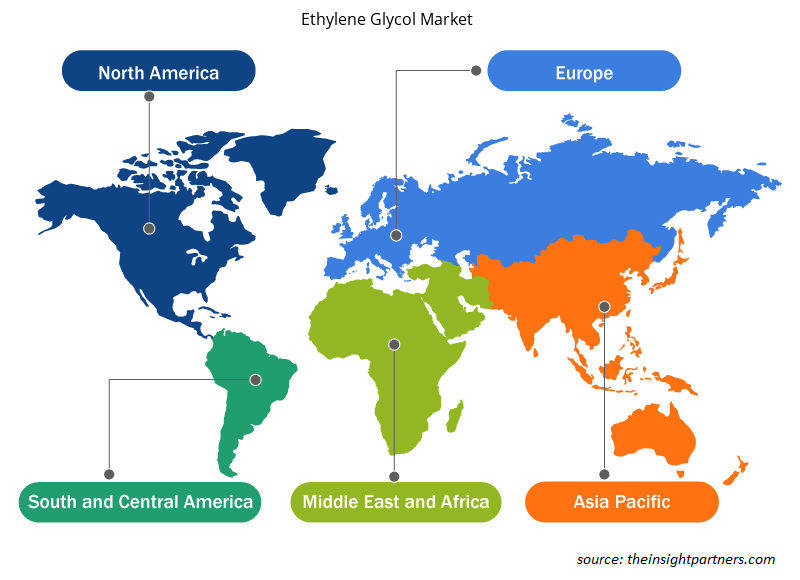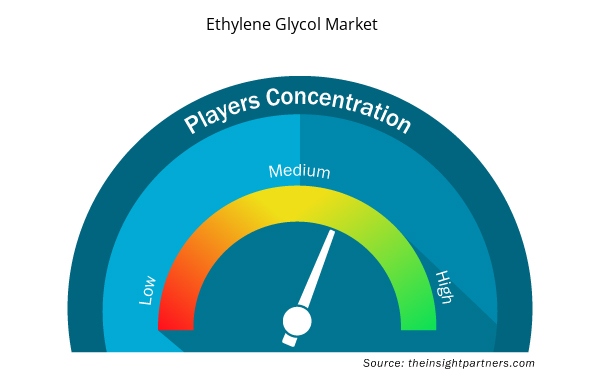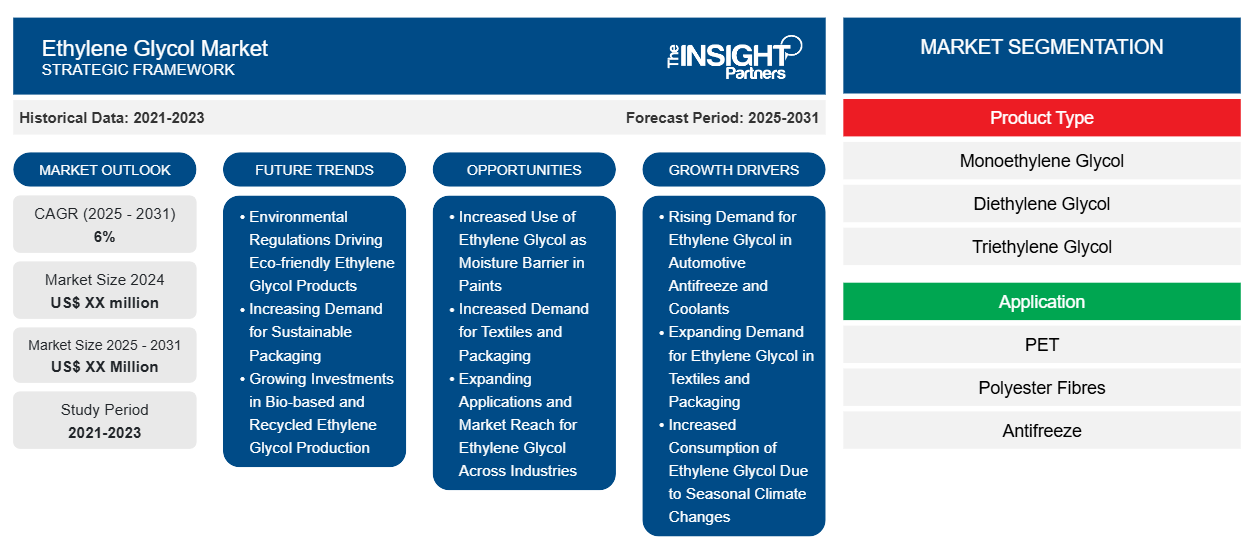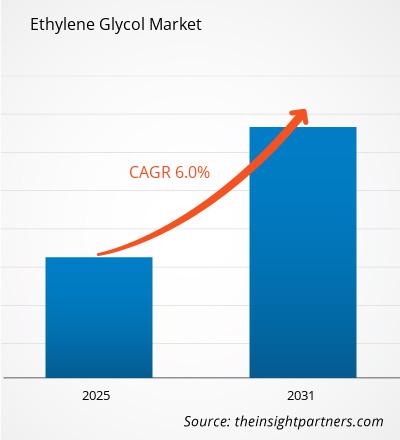Si prevede che il mercato dell'etilene glicole registrerà un CAGR del 6% dal 2024 al 2031, con una dimensione di mercato in espansione da XX milioni di dollari nel 2024 a XX milioni di dollari entro il 2031.
Il mercato del glicole etilenico comprende l'analisi per tipo di prodotto (glicole monoetilenico (MEG), glicole dietilenico (DEG), glicole trietilenico (TEG)); applicazione (PET, fibre di poliestere, antigelo, altri) e geografia (Nord America, Europa, Asia Pacifico, Medio Oriente e Africa e Sud e Centro America). Il glicole etilenico è un liquido incolore dal sapore dolce prodotto dall'ossido di etilene. La produzione di glicole etilenico dall'ossido di etilene coproduce glicole dietilenico (DEG) e glicole trietilenico (TEG). Il glicole etilenico è utilizzato principalmente nella produzione di fibre di poliestere, resine per bottiglie in PET e pellicole.
Scopo del rapporto
Il report Ethylene Glycol Market di The Insight Partners mira a descrivere il panorama attuale e la crescita futura, i principali fattori trainanti, le sfide e le opportunità. Ciò fornirà spunti a vari stakeholder aziendali, come:
- Fornitori/produttori di tecnologia: per comprendere le dinamiche di mercato in evoluzione e conoscere le potenziali opportunità di crescita, consentendo loro di prendere decisioni strategiche informate.
- Investitori: condurre un'analisi completa delle tendenze in merito al tasso di crescita del mercato, alle proiezioni finanziarie del mercato e alle opportunità esistenti lungo la catena del valore.
- Enti di regolamentazione: regolamentano le politiche e le attività di controllo sul mercato allo scopo di ridurre al minimo gli abusi, preservare la fiducia degli investitori e sostenere l'integrità e la stabilità del mercato.
Segmentazione del mercato del glicole etilenico
Tipo di prodotto
- Glicole monoetilenico
- Glicole dietilenico
- Glicole trietilenico
Applicazione
- ANIMALE DOMESTICO
- Fibre di poliestere
- Antigelo
- Altri
Personalizza questo report in base alle tue esigenze
Riceverai la personalizzazione gratuita di qualsiasi report, comprese parti di questo report, o analisi a livello nazionale, pacchetto dati Excel, oltre a usufruire di grandi offerte e sconti per start-up e università
- Scopri le principali tendenze di mercato in questo rapporto.Questo campione GRATUITO includerà analisi di dati che spaziano dalle tendenze di mercato alle stime e alle previsioni.
Fattori di crescita del mercato dell'etilene glicole
- Domanda crescente di glicole etilenico negli antigelo e nei refrigeranti per autoveicoli: il glicole etilenico è ampiamente utilizzato nella formulazione di antigelo e refrigeranti per veicoli. Con l'aumento della produzione e delle vendite globali di macchinari per autoveicoli, la domanda di glicole etilenico per garantire prestazioni e sicurezza dei veicoli aumenterà vertiginosamente nei prossimi anni.
- Domanda crescente di glicole etilenico nei tessuti e negli imballaggi: il glicole etilenico è una delle principali materie prime per la produzione di polietilene tereftalato, un materiale leader nei settori tessile e degli imballaggi. Le principali applicazioni finali del glicole etilenico sono, prima di tutto, i mercati tessili e dei beni di consumo, in particolare le fibre di poliestere e le bottiglie in PET.
- Aumento del consumo di glicole etilenico dovuto ai cambiamenti climatici stagionali: un cambiamento delle condizioni climatiche da una stagione all'altra richiede un maggiore consumo di prodotti antigelo sia in casa che nelle industrie. Ciò si traduce in un'elevata domanda di glicole etilenico come uno degli ingredienti principali utilizzati nei prodotti antigelo per ottenere la massima protezione contro il congelamento e una buona efficienza di raffreddamento.
Tendenze future del mercato del glicole etilenico
- Norme ambientali che guidano i prodotti ecocompatibili a base di glicole etilenico: sono state le normative ambientali più severe a imporre lo sviluppo di prodotti ancora più ecocompatibili. Poiché il glicole etilenico è biodegradabile e molto meno tossico di altri, offre un vantaggio alle aziende che cercano di conformarsi alle iniziative verdi e di avere un impatto ambientale ridotto.
- Domanda crescente di imballaggi sostenibili: la domanda di polietilene tereftalato aumenterà in base ai tassi di crescita delle industrie delle bevande e degli imballaggi. Ciò, a sua volta, aumenterà direttamente il consumo di glicole etilenico. Sempre più aziende cercheranno soluzioni di imballaggio sostenibili e, quindi, faciliteranno la crescita in questo mercato.
- Crescenti investimenti nella produzione di glicole etilenico riciclato e di origine biologica: la crescita dei consumatori e le normative sulla sostenibilità saranno i principali motori della domanda di glicole etilenico riciclato e di origine biologica. Per il produttore, i requisiti globali sulla sostenibilità e le richieste dei consumatori continueranno ad attrarre grandi investimenti in processi di produzione più ecologici e alternative per il glicole etilenico riciclato e di origine biologica.
Opportunità di mercato del glicole etilenico
- Aumento dell'uso di glicole etilenico come barriera all'umidità nelle vernici: oltre al suo utilizzo come antigelo per calcestruzzo, il glicole etilenico è stato ampiamente impiegato nel settore edile. Ha anche guadagnato utilizzo come barriera all'umidità nelle vernici. Ad esempio, lo sviluppo delle infrastrutture e l'espansione delle città sono ancora in pieno svolgimento. Si prevede che solo questi fattori aumenteranno ulteriormente l'uso di glicole etilenico nei materiali da costruzione.
- Aumento della domanda di tessuti e imballaggi: la crescita della popolazione e l'aumento dell'urbanizzazione aumentano la domanda di beni di consumo, tra cui tessuti e prodotti confezionati. Ciò offre quindi un'opportunità per l'etilenglicole nella produzione di materiali che trovano impiego con il cambiamento nelle preferenze dei consumatori.
- Ampliamento delle applicazioni e della portata di mercato per il glicole etilenico in tutti i settori: con l'innovazione nelle tecnologie di produzione, la produzione di glicole etilenico diventa più efficiente. Migliorando il processo e riducendo i costi, il glicole etilenico diventa ancora più disponibile con più applicazioni e una portata di mercato ancora più ampia in diversi settori.
Approfondimenti regionali sul mercato del glicole etilenico
Le tendenze regionali e i fattori che influenzano il mercato del glicole etilenico durante il periodo di previsione sono stati ampiamente spiegati dagli analisti di Insight Partners. Questa sezione discute anche i segmenti e la geografia del mercato del glicole etilenico in Nord America, Europa, Asia Pacifico, Medio Oriente e Africa e Sud e Centro America.

- Ottieni i dati specifici regionali per il mercato dell'etilene glicole
Ambito del rapporto di mercato dell'etilene glicole
| Attributo del report | Dettagli |
|---|---|
| Dimensioni del mercato nel 2024 | XX milioni di dollari USA |
| Dimensioni del mercato entro il 2031 | XX milioni di dollari USA |
| CAGR globale (2024 - 2031) | 6% |
| Dati storici | 2021-2023 |
| Periodo di previsione | 2025-2031 |
| Segmenti coperti | Per tipo di prodotto
|
| Regioni e Paesi coperti | America del Nord
|
| Leader di mercato e profili aziendali chiave |
|
Densità degli attori del mercato del glicole etilenico: comprendere il suo impatto sulle dinamiche aziendali
Il mercato del glicole etilenico sta crescendo rapidamente, spinto dalla crescente domanda degli utenti finali dovuta a fattori quali l'evoluzione delle preferenze dei consumatori, i progressi tecnologici e una maggiore consapevolezza dei benefici del prodotto. Con l'aumento della domanda, le aziende stanno ampliando le loro offerte, innovando per soddisfare le esigenze dei consumatori e capitalizzando sulle tendenze emergenti, il che alimenta ulteriormente la crescita del mercato.
La densità degli operatori di mercato si riferisce alla distribuzione di aziende o società che operano in un particolare mercato o settore. Indica quanti concorrenti (operatori di mercato) sono presenti in un dato spazio di mercato in relazione alle sue dimensioni o al valore di mercato totale.
Le principali aziende che operano nel mercato dell'etilene glicole sono:
- Società chimica Dow
- ExxonMobil
- Gruppo Formosa Plastics
- Petrolchimica Honam
- Ineos
Disclaimer : le aziende elencate sopra non sono classificate secondo un ordine particolare.

- Ottieni una panoramica dei principali attori del mercato del glicole etilenico
Punti di forza chiave
- Copertura completa: il rapporto copre in modo completo l'analisi di prodotti, servizi, tipologie e utenti finali del mercato dell'etilene glicole, fornendo una panoramica olistica.
- Analisi degli esperti: il rapporto è compilato sulla base della conoscenza approfondita di esperti e analisti del settore.
- Informazioni aggiornate: il rapporto garantisce la pertinenza aziendale grazie alla copertura di informazioni recenti e tendenze nei dati.
- Opzioni di personalizzazione: questo report può essere personalizzato per soddisfare le esigenze specifiche del cliente e adattarsi in modo appropriato alle strategie aziendali.
Il rapporto di ricerca sul mercato dell'etilene glicole può quindi aiutare a guidare il percorso di decodifica e comprensione dello scenario del settore e delle prospettive di crescita. Sebbene possano esserci alcune preoccupazioni valide, i vantaggi complessivi di questo rapporto tendono a superare gli svantaggi.
- Analisi storica (2 anni), anno base, previsione (7 anni) con CAGR
- Analisi PEST e SWOT
- Valore/volume delle dimensioni del mercato - Globale, regionale, nazionale
- Industria e panorama competitivo
- Set di dati Excel


- Transdermal Drug Delivery System Market
- Lymphedema Treatment Market
- Mail Order Pharmacy Market
- Medical Enzyme Technology Market
- Artwork Management Software Market
- Aesthetic Medical Devices Market
- Skin Tightening Market
- Mice Model Market
- Environmental Consulting Service Market
- Intradermal Injection Market

Report Coverage
Revenue forecast, Company Analysis, Industry landscape, Growth factors, and Trends

Segment Covered
This text is related
to segments covered.

Regional Scope
North America, Europe, Asia Pacific, Middle East & Africa, South & Central America

Country Scope
This text is related
to country scope.
Domande frequenti
The growing demand the demand for bio-based and recycled ethylene glycol is an emerging trend in the market.
The Asia Pacific market is expected to account for the highest CAGR during the forecast period owing to the growing construction industry in the region.
The MEG product segment accounted for the largest market share in 2023.
The growing demand from formulation of vehicle antifreeze and coolants is a key driver in the market.
Dow Chemical Company, ExxonMobil, Formosa Plastics Group, Honam Petrochemicals, Ineos, Nouryon, Reliance Industries Limited, SABIC, Shell Chemical, and Sinopec are some of the key players operating in the market.
The Ethylene Glycol Market is estimated to witness a CAGR of 6% from 2023 to 2031
Trends and growth analysis reports related to Chemicals and Materials : READ MORE..
1.Dow Chemical Company
2.ExxonMobil
3.Formosa Plastics Group
4.Honam Petrochemicals
5.Ineos
6.Nouryon
7.Reliance Industries Limited
8.SABIC
9.Shell Chemical
10.Sinopec
The Insight Partners performs research in 4 major stages: Data Collection & Secondary Research, Primary Research, Data Analysis and Data Triangulation & Final Review.
- Data Collection and Secondary Research:
As a market research and consulting firm operating from a decade, we have published and advised several client across the globe. First step for any study will start with an assessment of currently available data and insights from existing reports. Further, historical and current market information is collected from Investor Presentations, Annual Reports, SEC Filings, etc., and other information related to company’s performance and market positioning are gathered from Paid Databases (Factiva, Hoovers, and Reuters) and various other publications available in public domain.
Several associations trade associates, technical forums, institutes, societies and organization are accessed to gain technical as well as market related insights through their publications such as research papers, blogs and press releases related to the studies are referred to get cues about the market. Further, white papers, journals, magazines, and other news articles published in last 3 years are scrutinized and analyzed to understand the current market trends.
- Primary Research:
The primarily interview analysis comprise of data obtained from industry participants interview and answers to survey questions gathered by in-house primary team.
For primary research, interviews are conducted with industry experts/CEOs/Marketing Managers/VPs/Subject Matter Experts from both demand and supply side to get a 360-degree view of the market. The primary team conducts several interviews based on the complexity of the markets to understand the various market trends and dynamics which makes research more credible and precise.
A typical research interview fulfils the following functions:
- Provides first-hand information on the market size, market trends, growth trends, competitive landscape, and outlook
- Validates and strengthens in-house secondary research findings
- Develops the analysis team’s expertise and market understanding
Primary research involves email interactions and telephone interviews for each market, category, segment, and sub-segment across geographies. The participants who typically take part in such a process include, but are not limited to:
- Industry participants: VPs, business development managers, market intelligence managers and national sales managers
- Outside experts: Valuation experts, research analysts and key opinion leaders specializing in the electronics and semiconductor industry.
Below is the breakup of our primary respondents by company, designation, and region:

Once we receive the confirmation from primary research sources or primary respondents, we finalize the base year market estimation and forecast the data as per the macroeconomic and microeconomic factors assessed during data collection.
- Data Analysis:
Once data is validated through both secondary as well as primary respondents, we finalize the market estimations by hypothesis formulation and factor analysis at regional and country level.
- Macro-Economic Factor Analysis:
We analyse macroeconomic indicators such the gross domestic product (GDP), increase in the demand for goods and services across industries, technological advancement, regional economic growth, governmental policies, the influence of COVID-19, PEST analysis, and other aspects. This analysis aids in setting benchmarks for various nations/regions and approximating market splits. Additionally, the general trend of the aforementioned components aid in determining the market's development possibilities.
- Country Level Data:
Various factors that are especially aligned to the country are taken into account to determine the market size for a certain area and country, including the presence of vendors, such as headquarters and offices, the country's GDP, demand patterns, and industry growth. To comprehend the market dynamics for the nation, a number of growth variables, inhibitors, application areas, and current market trends are researched. The aforementioned elements aid in determining the country's overall market's growth potential.
- Company Profile:
The “Table of Contents” is formulated by listing and analyzing more than 25 - 30 companies operating in the market ecosystem across geographies. However, we profile only 10 companies as a standard practice in our syndicate reports. These 10 companies comprise leading, emerging, and regional players. Nonetheless, our analysis is not restricted to the 10 listed companies, we also analyze other companies present in the market to develop a holistic view and understand the prevailing trends. The “Company Profiles” section in the report covers key facts, business description, products & services, financial information, SWOT analysis, and key developments. The financial information presented is extracted from the annual reports and official documents of the publicly listed companies. Upon collecting the information for the sections of respective companies, we verify them via various primary sources and then compile the data in respective company profiles. The company level information helps us in deriving the base number as well as in forecasting the market size.
- Developing Base Number:
Aggregation of sales statistics (2020-2022) and macro-economic factor, and other secondary and primary research insights are utilized to arrive at base number and related market shares for 2022. The data gaps are identified in this step and relevant market data is analyzed, collected from paid primary interviews or databases. On finalizing the base year market size, forecasts are developed on the basis of macro-economic, industry and market growth factors and company level analysis.
- Data Triangulation and Final Review:
The market findings and base year market size calculations are validated from supply as well as demand side. Demand side validations are based on macro-economic factor analysis and benchmarks for respective regions and countries. In case of supply side validations, revenues of major companies are estimated (in case not available) based on industry benchmark, approximate number of employees, product portfolio, and primary interviews revenues are gathered. Further revenue from target product/service segment is assessed to avoid overshooting of market statistics. In case of heavy deviations between supply and demand side values, all thes steps are repeated to achieve synchronization.
We follow an iterative model, wherein we share our research findings with Subject Matter Experts (SME’s) and Key Opinion Leaders (KOLs) until consensus view of the market is not formulated – this model negates any drastic deviation in the opinions of experts. Only validated and universally acceptable research findings are quoted in our reports.
We have important check points that we use to validate our research findings – which we call – data triangulation, where we validate the information, we generate from secondary sources with primary interviews and then we re-validate with our internal data bases and Subject matter experts. This comprehensive model enables us to deliver high quality, reliable data in shortest possible time.


 Ottieni un campione gratuito per questo repot
Ottieni un campione gratuito per questo repot